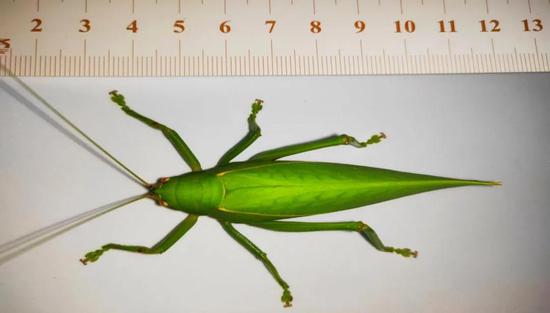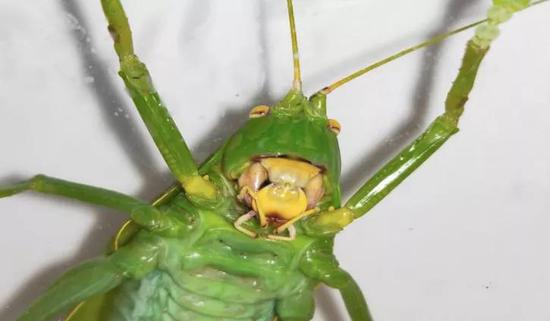Sichuan Chengdu Hua Xi Insect Museum curator Zhao Li recently found a giant katydid 螽(音“中”)斯 with a body length of 8cm in Qingcheng Mountain 青城山, which is twice as big as the common katydids of Sichuan past, refreshing the record of Sichuan’s largest katydid.
”Its wings look very broad from the front and back, more like a leaf,” The katydid is the largest katydid in Sichuan, and the largest katydid in China is the giant leaf katydid 巨拟叶螽

giant leaf katydid 巨拟叶螽
from Xishuangbanna 西双版纳 , which can be more than 12.5cm in length.
Zhao Li introduced, this katydid belongs to the subfamily Pseudophyllinae of Arabidopsis katydids, belongs to the insectoid Insecta Orthoptera Orthoptera katydids Tettigoniidae. currently the world records 19 families 260 genera (subgenera) 998 species (subspecies), mainly distributed in the neotropics, paleotropics and subtropics. “A total of 16 genera and 39 species (subspecies) have been recorded in the Chinese subfamily Orthoptera Tettigoniidae.” “All the katydids found in the Sichuan region in the past were small and medium-sized species, the largest being the large katydid that is no more than 7cm in length,” Zhao Li said, “This mountain subleaf katydid has a very fat abdomen, while the abdomen volume of the large katydid with a length of 7cm is only a fraction of its size.” Compared to the carnivorous katydids, the mountain subleaf katydid is a ‘gentle giant’ that is vegetarian and catches insects.” Zhao Li said that when reared so far, it has been found that it not only feeds on the leaves of the Nanmu tree 楠木树 , but also the leaves of plants in the chitin 壳斗科 family.
Nocturnal katydids lay eggs on tree trunks.
”This mountain subleaf katydid is nocturnal and hides in the canopy layer during the day and only goes to the trunk at night to lay its eggs, so its presence is rarely known.” When Zhao Li found it, it was on the trunk of a Nanmu tree , using a spawner to burrow into the bark to lay its eggs.
Nanmu is a very tall tree, reaching up to more than 30 meters in height and up to 1 meter in diameter at breast height. “Because this katydid mimics the leaves of the Nanmu tree, it hides in the tree during the day and won’t be noticed.”
Zhao Li lamented that the giant katydid has not been found because it is too rare, “I’ve seen its limbs before in Jiulonggou九龙沟 and Xiling Snow Mountain 西岭雪山 . All of them are wings or heads left over from being eaten by birds.”

The head of a mountain subleaf katydid. Chengdu Huaxi Insect Museum for a picture of the head of a mountain Asian leaf katydid .
It is known that katydids lay their eggs on the shallow surface of the soil and some larvae die if they can’t get out of the soil, so will the mountain leaf katydid survive if it lays its eggs in the bark of a tree?
”It has a very specific way of laying its eggs and I think the purpose of laying its eggs in the bark is to keep them moist. Also the bark effectively protects its eggs from being damaged by other things.” Zhao Li said the insects have a low survival rate, so they use a strategy of laying large numbers of eggs. “Most katydids have a short lifespan, hatching in the spring and dying at the end of October. However, with artificial warmth, some species of katydids can live until the following spring.”
